|
To the left of the North porch stands the churchyard cross, the original of which was made from Caen stone and probably first stood on the south side of the church. Most medieval foundations had one of these crosses, marking the churchyard as consecrated ground and a place of penance. In pre-Reformation times it was customary to perform penances at the churchyard cross, and for this reason they were also referred to as 'weeping crosses.' Another name for them was palm crosses, so given because they were ornamented with wreaths of palm on Palm Sunday for processions. These processions around the church usually began and finished at the site of the cross.
Although St Michael's cross survived the start of the Reformation it didn't survive the Civil War, being taken down in 1643 by an officer of the Earl of Manchester. It was during 19th century restoration work that parts of it were found beneath the floor of the church and then moved to the belfry for safekeeping. The present churchyard cross is a reconstruction, only the lower part of the capital being from the 15th century original. Mounted on a square stone block that sits on a two-tiered octagonal plinth, it also acts as a war memorial dedicated to 38 men of the parish and congregation who gave their lives in the First World War. The inscription reads thus:
In Grateful Memory of Men of this Parish and Congregation who died for their Country in the Great War 1914-1919
R.I.P.
Let those who come after see to it that their names are not forgotten
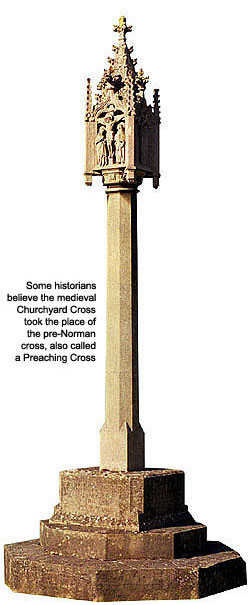 Inscriptions on memorials such as tombs, headstones and church plaques, tell us much about past life: not only giving us birth and death dates, but very often including details of the circumstance and character of the person commemorated.
Inscriptions on memorials such as tombs, headstones and church plaques, tell us much about past life: not only giving us birth and death dates, but very often including details of the circumstance and character of the person commemorated.
But such information is generally only possible of inscriptions etched onto monuments over the past 200 years or so: any earlier and natural erosion of the stone can make them unreadable.
In Hertfordshire we are extremely fortunate in having a record of virtually every monument inscription (now readable or not) found in the county's churches and churchyards over the last 600 years. A lot of this detail is due to the 17th century historian John Weever and to the more widely read county historians, Chauncy, Salmon, Clutterbuck and Cussans, although they mainly concerned themselves with recording monument details of the more 'distinguished' members of society - not always the 'ordinary' people buried in churchyards.
The man we owe most to, though, is William Blyth Gerish (1865–1921), a former bank worker, archaeologist, genealogist and one time resident of Bishop's Stortford, who, over a period of 6 years (1907–1913), with the aid of helpers, recorded every monument inscription in Hertfordshire – the first county ever to complete such a task. His manuscript comprised 8,000 pages and contained 70,000 entries.
But although Gerish's records are unique, what he didn't always do was copy exact wording on all memorials, or make public any personal maps or reference points he may have used to note where inscriptions were located. The probable reason for this was because he knew that memorials would one day be lost to future generations, so only concerned himself with making lists of names and dates and, when found, recording any bonus information regarding relationships and occupations. (See Guide 12 for a short biography of William Blyth Gerish)
In Bishop's Stortford we are doubly fortunate to have had an outstanding local historian by the name of John Laybank Glasscock (1854–1929). A contemporary of Gerish, and with an equal interest in archaeology and genealogy, he made his own lists of St Michael's monument inscriptions, prior to 1881. More importantly, he grouped his lists to show the exact part of the church or churchyard 'plot' in which he found them. Like Gerish, he also didn’t record the precise wording of all inscriptions he found, nor did he find all of the memorials later recorded by Gerish, but he (and others) did discover some that Gerish missed.
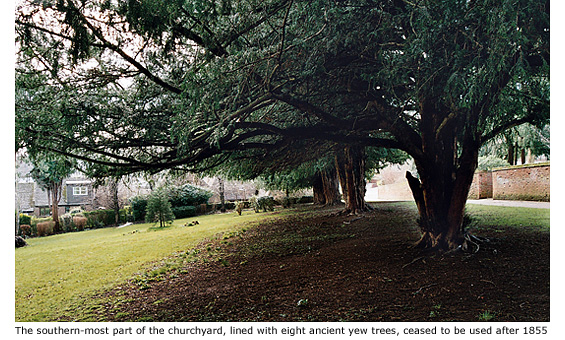
Both men's records have been in the public domain for many years – Gerish's manuscript in the British Library, as well as on microfilm at the Society of Genealogists; Glasscock's notes held by Bishop's Stortford Museum and H.A.L.S., and also published (1881) in his book ‘The Records of St Michael’s Parish Church Bishop’s Stortford.’ These records have since proved invaluable; many memorial inscriptions that were barely readable a century ago, now eroded completely.
Hertfordshire Family History Society (H.F.H.S.), established in 1977, has transcribed all extant memorials in 115 parishes of Hertfordshire in 87 books to date: a task that is certainly indebted to Gerish's manuscripts and the notes of other historians, but owes far more to the skill and dedication of the Society's members. In preperation for each publication, they visit the church and churchyard that is the subject and physically clean and transcribe each and every visible memorial, recording far more information than Gerish, or others, ever did. And with more than 40 county churches and churchyards still to be fully explored, the Society's work is far from over. One of their most recent (2006) publications 'Monumental Inscriptions of The Parish Church of St Michael Bishop's Stortford' includes maps of the church and churchyard, created by the F.H.S. using Glasscock’s detailed lists to show where memorials can still be found.
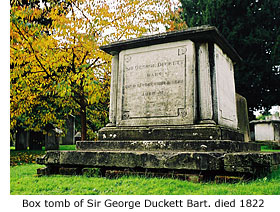 What makes this publication all the more interesting is that no interments have taken place in St Michael’s church or churchyard for over 150 years What makes this publication all the more interesting is that no interments have taken place in St Michael’s church or churchyard for over 150 years
The early 1800s was a time of dramatic population growth and, naturally, a growing number of deaths, so by the 1850s many city churchyards were over-full. They were also exclusively Anglican, but more importantly were suspected of being harbourers of contamination and a danger to public hygiene. This alone forced many churchyards to close and brought about the Metropolitan Interment Act of 1850, allowing the provision of publicly funded cemeteries in London. It was, though, a problem countrywide and at that time cremation wasn't an option.
In rural areas many parish churches were accommodating the dead by extending their churchyards into neighbouring fields, but there were obvious limits to this practice. Bishop's Stortford had two parish churchyards at that time – St Michael's and All Saints – and two much smaller graveyards for Independents – the Baptist and Congregational chapels. But burial ground was still at a premium, and many Independents, deprived of space in their own graveyards, had to be buried at St Michael's or in profit-making private cemeteries.
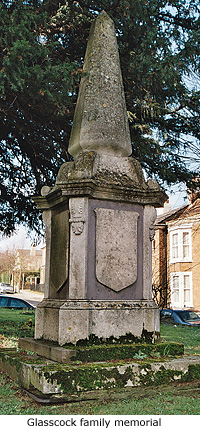 The solution came in 1853 with an extension to the Metropolitan Interment Act, allowing local authorities, countrywide, to purchase land for use as a cemetery. The following year St Michael's churchwardens received a letter from the Home Secretary Lord Palmerston, informing them that all burials within parish churches would cease with immediate effect, and after 1 June 1855 in the parish churchyards and in the burial grounds of the Baptist and Congregational chapels. The solution came in 1853 with an extension to the Metropolitan Interment Act, allowing local authorities, countrywide, to purchase land for use as a cemetery. The following year St Michael's churchwardens received a letter from the Home Secretary Lord Palmerston, informing them that all burials within parish churches would cease with immediate effect, and after 1 June 1855 in the parish churchyards and in the burial grounds of the Baptist and Congregational chapels.
As a result of this a burial ground had to be found and on 22 June 1854 a Burial Board, consisting of nine members, was formed. A subsequent meeting of the Vestry authorised the Burial Board to purchase land in Apton Fields and, at a cost of no more than £5,000, construct a cemetery and build the necessary chapels. The Vestry also sanctioned the borrowing of the money and charged the future poor rates for its repayment. Within a year New Cemetery was opened for both Anglican and Independent burials (See Guide 14 – New Cemetery).
In the 17th century parts of St Michael’s churchyard were fenced in and bushes and brambles planted to further enclose it. This would have included that part of the churchyard that stretched southwards as far as Apton Road. Local and district residents were regularly interred here, as were most of the town’s earlier plague victims – their bodies brought to this part of the churchyard via Deadmans Lane, now better known as Church Street (See Guide 15). During the worst period of the Great Plague (1666–8), 231 deaths were recorded in Bishop’s Stortford – one sixth of the town’s population.
A wooden cross would have marked most early burials in this part, but by comparing the alphabetically recorded list of Gerish and the more detailed lists of Glasscock, it is apparent that between them they found and recorded approximately 134 headstones in the south churchyard. That said, there can be little doubt that far more than this number once existed here. What happened to them after Gerish visited the churchyard in 1908 is unknown, but at that time 45 headstones had been removed from their original positions and built into the vicarage garden wall that borders the churchyard. These headstones are still in evidence and most are still readable, but thanks to the dedication of the F.H.S.'s members, even those inscriptions not so legible have been transcribed. They all make for fascinating reading and from them we get, in microcosm, a picture of life, and death, in Bishop’s Stortford in the late 18th and early 19th century.
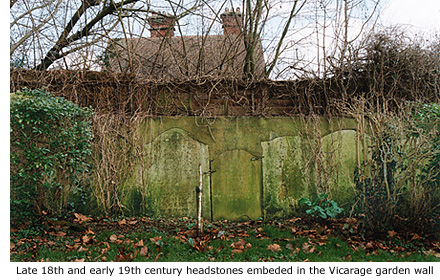 Of the 45 headstones embeded in the vicarage wall, eight are from the 1700s – the earliest of which is dated 1780 and commemorates Robert Kippage who died aged 35 – and 33 are from the 1800s – the latest dated 1855, commemorating Harriet Susanna Titchmarsh who died aged 37. Three of these headstones were unreadable even in Gerish's day, but in total at least 60 people – 34 male and 27 female – are remembered here, mostly from family graves. Two of these women died in ‘childbed’ and there were 6 infant deaths, ranging in age from 1 year 5 months to 3 years 8 months. Three children are also recorded; two aged 7, and one aged 12. Despite the high mortality rate of the young at that time, we find that 12 of these people exceeded their allotted 3 score years and 10 – six dying in their 70s, five in their 80s, and one woman, Mrs Sarah Ashford, surviving to the age of 95. She died in 1814. (A similar high percentage of people living beyond the age of 70 are apparent on memorials throughout the churchyard.) Of the 45 headstones embeded in the vicarage wall, eight are from the 1700s – the earliest of which is dated 1780 and commemorates Robert Kippage who died aged 35 – and 33 are from the 1800s – the latest dated 1855, commemorating Harriet Susanna Titchmarsh who died aged 37. Three of these headstones were unreadable even in Gerish's day, but in total at least 60 people – 34 male and 27 female – are remembered here, mostly from family graves. Two of these women died in ‘childbed’ and there were 6 infant deaths, ranging in age from 1 year 5 months to 3 years 8 months. Three children are also recorded; two aged 7, and one aged 12. Despite the high mortality rate of the young at that time, we find that 12 of these people exceeded their allotted 3 score years and 10 – six dying in their 70s, five in their 80s, and one woman, Mrs Sarah Ashford, surviving to the age of 95. She died in 1814. (A similar high percentage of people living beyond the age of 70 are apparent on memorials throughout the churchyard.)
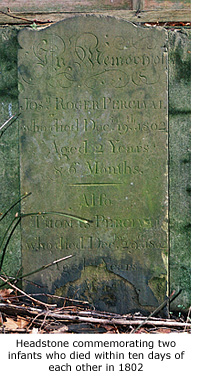 And although all churchyards were Anglican from the time of the Reformation, parish priests were obliged to bury any parish member whatever their persuasion. Evidence of this is found here on the headstone of Thomas Sparling who died in 1851, aged 84. 'Distinguished for amiability, benevolence and integrity, for 40 years he devotedly sustained the office of Deacon in the Independent Chapel in this town and secured himself the affection of a large circle of Christian friends' (Gerish). And although all churchyards were Anglican from the time of the Reformation, parish priests were obliged to bury any parish member whatever their persuasion. Evidence of this is found here on the headstone of Thomas Sparling who died in 1851, aged 84. 'Distinguished for amiability, benevolence and integrity, for 40 years he devotedly sustained the office of Deacon in the Independent Chapel in this town and secured himself the affection of a large circle of Christian friends' (Gerish).
Another headstone remembers Elizabeth Thompson, wife of William Thompson, Coachmaker of Hertford, who died in 1825 aged 25, and their daughter, Mary Ann, who died in May 1825, aged 1 yr 5 m. The husband and father, William Thompson, is also remembered on the headstone, although he died in 1865, aged 70, at Geelong, Australia. He may have immigrated to Australia after the loss of his family to start a new life, or he may have fallen foul of the law and been sent there as a convict. If the latter were the case, it would have been before 1850 when transportation of convicts ceased. (A quick bit of research on the Internet reveals that a William Thompson was indeed buried in 1865 at Geelong Eastern Cemetery, but nothing to tell of when or why he arrived in Australia.)
*It is assumed that the southern-most part of the churchyard was not used as consecrated ground after 1855, but a former town historian wrote that when the wife of Rev Francis Rhodes died in 1873, her wish to be buried in a ‘distant corner’ of the churchyard was fulfilled. It is also said that in later years two of her seven sons were interred in the same plot, and that the ‘distant corner’ referred to now forms part of the rear gardens of Nos 20 and 22 Apton Road.
All three names are commemorated on a small monument within the church:
RHODES Basil, son Rev F.W. & Louisa R, died March13 1851, aged 11 days
RHODES Frederic, son as above, died August 19 1854, aged 5 weeks
RHODES Louisa, wife Rev. Francis Wm Rhodes, died November 1 1873, aged 57
Gerish didn’t note where the memorial was sited but Glasscock did, putting it in the churchyard south of the church i.e. the old churchyard. The town historian, however, may have got the detail wrong in recording that two of Louisa's sons were 'later' buried with her. As both children died before the 1855 ban on all future churchyard burials, it seems more likely that it was they who were interred first and that Louisa, who died 18 years after the ban, was interred last - maybe illegally.
The 45 headstones embeded in the vicarage wall are but a small sample of over 450 churchyard memorials revealed in H.F.H.S's publication – most indicating family burials. Some inscriptions include deceased family members not interred in the same grave but this, as now, was common practice. The number of people buried in the entire churchyard since the church was built is incalculable, but notes made by Glasscock, Gerish and others detail over 850 names, including those on the War Memorial. In addition there are currently 39 more recent markers for ashes interments, the names of these former parishioners recorded in a Book of Commemoration inside the church. Also inside the church are a further 107 memorials (See Church Interior).
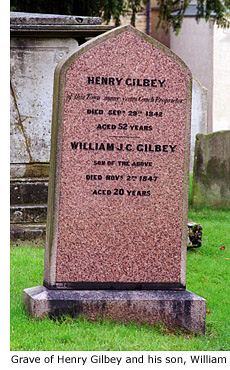 The statistics that can be gleaned from this book are too numerous to mention here, as are the many fascinating inscriptions, but three are certainly worthy of mention:
The statistics that can be gleaned from this book are too numerous to mention here, as are the many fascinating inscriptions, but three are certainly worthy of mention:
The earliest headstone dates back to 1726, recording 'Nathaniel Jones, brazier of this town, who died aged 84'; and the oldest person recorded was William Francis who died May 13th 1787, aged 100. A family with a sense of humour gave the following epitaph: 'Matthew Handscombe, bricklayer of this parish, who departed this life October 10th 1807 aged 52 years. In perfect health at work when down I fell without permission for to bid farewell.'
The vast majority of churchyard memorials are headstones, but several box tombs and obelisks reflect the higher social status of some former residents. These include the Hawkes family, owners of the town's largest brewery 1780–1898; Sir George Duckett, co-founder of the Stort Navigation; the Gee family, prominent town solicitors; and the Glasscock family, owners of a town building firm. The marble headstone of Henry Gilbey, father of Sir Walter Gilbey, is sited near to the South porch.
The family names most often found on memorials include BARKER, DUGARD, FEAST, GLASSCOCK, HANDSCOMBE, JONES, SEYMOUR, TAYLOR, TYLER, WARNER, YARDLEY.
*Memorial inscriptions used in this text were taken from ‘Monumental Inscriptions of The Parish Church of St Michael Bishop's Stortford’, and used by kind permission of Hertfordshire Family History Society. For more information on the Society’s activities and publications, email the Secretary at secretary@hertsfhs.org.uk or visit the Society’s website at www.hertsfhs.org.uk
*Hertfordshire Historians
John Weever (1576–1632) Ancient Funeral Monuments 1631
Sir Henry Chauncy (1632–1719) The Historical Antiquities of Hertfordshire 1700
Nathanael Salmon (1675–1742) A History of Hertfordshire 1728
Robert Clutterbuck (1772–1831) The History and Antiquities of Hertfordshire
John Edwin Cussans (1837–1899) History of Hertfordshire 3 vols 1870–81
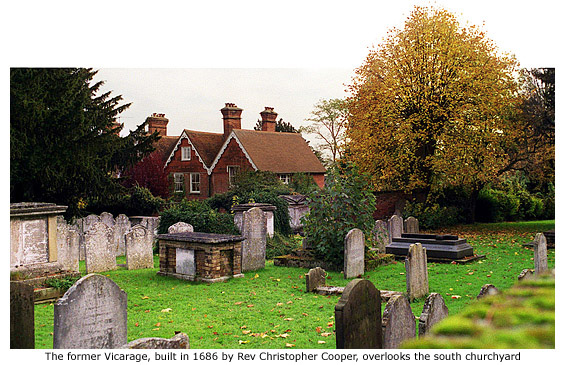
The three annual fairs of the Middle Ages, *Michaelmas, *Ascension and *Corpus Christi, were all in existence by 1320. These took place partly in the churchyard up until the 16th century but thereafter only in the wide thoroughfare of Windhill. On each of these occasions townspeople would take a days holiday and villagers from the surrounding area would bring in merchandise and produce to be sold.
*Michaelmas Day is the feast of Saint Michael the Archangel, celebrated on 29 September. This is traditionally the last day of the harvest season. The harvest season used to begin on 1 August and was called Lammas, meaning 'loaf Mass'. This stems back some 500 years when farmers made loaves of bread from the new wheat crop and gave them to their local church. They were then used as the Communion bread during a special mass thanking God for the harvest. The custom ended when Henry VIII broke away from the Catholic Church, and nowadays we have harvest festivals at the end of the season. Generally, a loaf of bread takes the shape of a wheatsheaf. Farmers celebrated the end of the harvest with a big meal called a harvest supper, eaten on Michaelmas Day. This was rather like a Christmas dinner, but as turkeys were unknown at that time, a goose stuffed with apples was eaten. Goose Fairs are still held in some English towns, but geese are no longer sold.
*Ascension Day (May or June) is celebrated 40 days after Easter. The name Ascension comes from accounts in the Bible that tell of Jesus being taken up into heaven by God.
*Corpus Christi wasn't recognized in England until 1318. Numerous guilds were then established to honour the Blessed Sacrament as it was carried in procession. The Blessed Sacrament was exposed for forty hours in memory of the time Jesus spent in the tomb.
Four feasts are celebrated in the Christian calendar, 'signposts' that enable Christians to follow in the footsteps of Jesus. Each feast is celebrated in order because one leads naturally onto the next. To be a fully active member of the Body of Christ (Corpus Christi), one must first ascend (Ascension) with open mind and heart and allow God to fill the soul with love. Thus enabled to receive the gifts and promptings of the Holy Spirit (Pentecost), the mind and body is empowered and activated by the love of God and the inspiration of the Holy Spirit (Trinity). MORE PICTURES
|

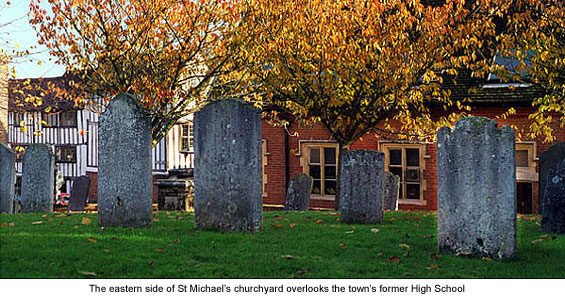

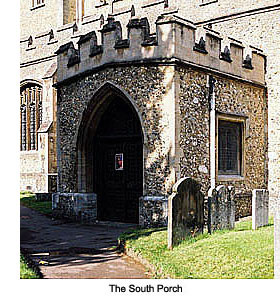 The South Porch is entered through its original oak doors. Inside can be found a fragment of the holy water stoop; a wicker basket high up in the rafters once used to store bread for collection by the poor; four stone plaques recording past benefactors of the parish; and four small stained glass windows each donated to the memory of past parishioners.
The South Porch is entered through its original oak doors. Inside can be found a fragment of the holy water stoop; a wicker basket high up in the rafters once used to store bread for collection by the poor; four stone plaques recording past benefactors of the parish; and four small stained glass windows each donated to the memory of past parishioners. Inscriptions on memorials such as tombs, headstones and church plaques, tell us much about past life: not only giving us birth and death dates, but very often including details of the circumstance and character of the person commemorated.
Inscriptions on memorials such as tombs, headstones and church plaques, tell us much about past life: not only giving us birth and death dates, but very often including details of the circumstance and character of the person commemorated.
 What makes this publication all the more interesting is that no interments have taken place in St Michael’s church or churchyard for over 150 years
What makes this publication all the more interesting is that no interments have taken place in St Michael’s church or churchyard for over 150 years The solution came in 1853 with an extension to the Metropolitan Interment Act, allowing local authorities, countrywide, to purchase land for use as a cemetery. The following year St Michael's churchwardens received a letter from the Home Secretary Lord Palmerston, informing them that all burials within parish churches would cease with immediate effect, and after 1 June 1855 in the parish churchyards and in the burial grounds of the Baptist and Congregational chapels.
The solution came in 1853 with an extension to the Metropolitan Interment Act, allowing local authorities, countrywide, to purchase land for use as a cemetery. The following year St Michael's churchwardens received a letter from the Home Secretary Lord Palmerston, informing them that all burials within parish churches would cease with immediate effect, and after 1 June 1855 in the parish churchyards and in the burial grounds of the Baptist and Congregational chapels. Of the 45 headstones embeded in the vicarage wall, eight are from the 1700s – the earliest of which is dated 1780 and commemorates Robert Kippage who died aged 35 – and 33 are from the 1800s – the latest dated 1855, commemorating Harriet Susanna Titchmarsh who died aged 37. Three of these headstones were unreadable even in Gerish's day, but in total at least 60 people – 34 male and 27 female – are remembered here, mostly from family graves. Two of these women died in ‘childbed’ and there were 6 infant deaths, ranging in age from 1 year 5 months to 3 years 8 months. Three children are also recorded; two aged 7, and one aged 12. Despite the high mortality rate of the young at that time, we find that 12 of these people exceeded their allotted 3 score years and 10 – six dying in their 70s, five in their 80s, and one woman, Mrs Sarah Ashford, surviving to the age of 95. She died in 1814. (A similar high percentage of people living beyond the age of 70 are apparent on memorials throughout the churchyard.)
Of the 45 headstones embeded in the vicarage wall, eight are from the 1700s – the earliest of which is dated 1780 and commemorates Robert Kippage who died aged 35 – and 33 are from the 1800s – the latest dated 1855, commemorating Harriet Susanna Titchmarsh who died aged 37. Three of these headstones were unreadable even in Gerish's day, but in total at least 60 people – 34 male and 27 female – are remembered here, mostly from family graves. Two of these women died in ‘childbed’ and there were 6 infant deaths, ranging in age from 1 year 5 months to 3 years 8 months. Three children are also recorded; two aged 7, and one aged 12. Despite the high mortality rate of the young at that time, we find that 12 of these people exceeded their allotted 3 score years and 10 – six dying in their 70s, five in their 80s, and one woman, Mrs Sarah Ashford, surviving to the age of 95. She died in 1814. (A similar high percentage of people living beyond the age of 70 are apparent on memorials throughout the churchyard.) And although all churchyards were Anglican from the time of the Reformation, parish priests were obliged to bury any parish member whatever their persuasion. Evidence of this is found here on the headstone of Thomas Sparling who died in 1851, aged 84. 'Distinguished for amiability, benevolence and integrity, for 40 years he devotedly sustained the office of Deacon in the Independent Chapel in this town and secured himself the affection of a large circle of Christian friends' (Gerish).
And although all churchyards were Anglican from the time of the Reformation, parish priests were obliged to bury any parish member whatever their persuasion. Evidence of this is found here on the headstone of Thomas Sparling who died in 1851, aged 84. 'Distinguished for amiability, benevolence and integrity, for 40 years he devotedly sustained the office of Deacon in the Independent Chapel in this town and secured himself the affection of a large circle of Christian friends' (Gerish). The statistics that can be gleaned from this book are too numerous to mention here, as are the many fascinating inscriptions, but three are certainly worthy of mention:
The statistics that can be gleaned from this book are too numerous to mention here, as are the many fascinating inscriptions, but three are certainly worthy of mention: